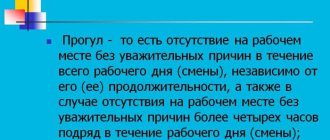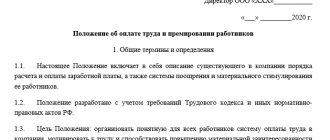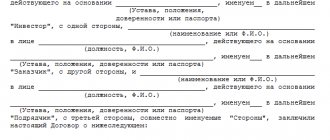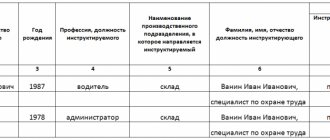Business lawyer > Labor law > What are the working conditions: assessment system and classification
It is the employer's responsibility to create optimal working conditions for employees. Rational intensity of work and a comfortable environment make it possible to obtain improved results in all spheres of the economy. Failure to comply with legal regulations when organizing the work of a team not only reduces its productivity. It directly violates the rights of employees and can cause harm to their health or life. In this case, management risks receiving a fine from the Labor Inspectorate and judicial authorities, and in some cases even facing criminal liability.
Factors influencing labor intensity
The Labor Code allows you to understand what working conditions are like. In 2013, a separate federal law No. 426 was adopted. Legal acts approved acceptable standards, set out criteria for assessing working conditions, provided for the procedure for working in difficult and dangerous conditions and compensation for personnel for risks.
It is incorrect to assume that working conditions only include the creation of safe workplaces. The concept includes a whole range of requirements.
These include:
Schedule
- work schedules
- maintaining the balance of work and rest
- the correct level of intensity of work performed
- permission to work for employees based on their qualifications
- their certification in terms of special skills, ability to use equipment and knowledge of safety precautions
All these requirements must be observed and controlled by the management of the enterprise (Article 212 of the Labor Code).
Work intensity is one of the most important factors in determining working conditions. The indicator is calculated based on human resource costs per unit of labor time.
Legislation
All harmful conditions and division into classes are based on the Labor Code of the Russian Federation. Several Federal laws that regulate the procedure for conducting special assessments and identifying other characteristics of activities have a great influence. They also determine the procedure for providing benefits and other additional compensation.
Class three, which is also divided into four additional levels, implies hazardous operating conditions. Employees who belong to it are entitled to benefits and bonuses in accordance with the law.
In conclusion, we can say that all hazardous conditions are divided into classes and are regulated by the Labor Code and individual Federal laws in accordance with the type of activity performed.
Nuances of monitoring
The assessment can be carried out per employee, per production group, or per average of all staff units of the enterprise within the reporting period (working hour, day, week, etc.).
The assessment is comprehensive and includes:
- expenditure of physical strength
- consumption of mental resources
- emotional background
- work environment
- the presence of motivation of a material and other nature
- convenience of work organization, etc.
The assessment procedure must take into account the intensity group to which the employee or the enterprise as a whole belongs.
There are four of them:
Increased physical labor
- Work that does not require physical labor.
- Light work.
- Work of average physical difficulty.
- Work under conditions of increased physical activity.
The first group mainly includes employees who perform sedentary work and engage in intellectual work. Light physical activity is used in the service segment or in production occupations where personnel monitor the operation of mechanized equipment. Factory and plant production, as well as agricultural enterprises, are classified as organizations of medium-sized physical labor. And increased loads are the norm in hazardous and heavy industries, for example, in the extraction of hydrocarbons and metals.
Monitoring criteria
Monitoring of work intensity should be carried out based on factors that directly influence the formation of this indicator:
- level of employment of each employee
- speed of work
- the size and severity of objects that the employee has to use during work
- volume of work performed
- compliance with sanitary and hygienic standards
For each of the criteria, there are maximum permissible values and standards approved at the state level.
Difficulty of work
In addition, the assessment takes into account:
- level of complexity of the technological process
- convenience of the workplace
- quality of the employee (gender, age, state of health, degree of fatigue, medical limitations, standard of living, social status, etc.)
Based on the number of factors that need to be taken into account, intensity monitoring is a multifactorial and complex process. It requires the development and application of special techniques that are capable of analyzing all the characteristics of the work.
Workplace standard
Organizations are obliged to ensure compliance with labor standards, the main of which are:
- providing employees with everything they need to work;
- creation of appropriate working conditions;
- Conducting a special assessment of workplace conditions.
The employer must also comply with sanitary and hygienic requirements related to the equipment of the workplace. For this purpose, rooms for eating and rest are equipped, and there must be a point with a first aid kit.
SanPiN 2.2.4.548-96 defines microclimate requirements and regulates temperature and ventilation standards.
Noise in the room and illumination of the working surface are strictly regulated. Artificial lighting in computer areas should be provided by a system of general uniform light. The noise level in the office and other workplaces is regulated by the conditions of SanPiN 2.2.4/2.1.8.562-96.
Using the results
Intensity monitoring allows you to adjust your workflow and achieve planned results as efficiently as possible.
Violation of the intensity indicator has an inversely proportional effect on labor productivity:
- Optimal load generates optimal performance.
- By increasing the voltage during work, you can provoke a jump in productivity, but only for a short period of time.
- Long-term increased exploitation of employees will invariably lead to decreased productivity.
Despite the statistics, many managers try to increase productivity precisely by increasing the intensity of workers' work. Coercive measures are still in use, such as orders to work beyond normal limits under the threat of dismissal or refusal to sign an application for another vacation.
Worker wear and tear
It should be borne in mind that even if there is positive motivation in the form of additional bonuses or teamwork in emergency mode for the overall benefit of the enterprise, prolonged excessive workload has a negative effect on staff. Fatigue increases, physical endurance decreases, and illness and nervous exhaustion can be a side effect. As a result, an unfavorable climate is created in the team, employees go on sick leave and cease to achieve not only improved, but also standard results.
Experts recommend increasing productivity through the introduction of innovative technologies and optimization of technological processes. This is much more effective than using human resources in work “for wear and tear”. In addition, the latter option for organizing labor is legally limited and requires the management of the enterprise to pay numerous compensation expenses for employees.
Existing conditions
The legislation provides for the division of characteristics inherent in the working environment into 4 groups depending on the influence exerted on people by existing production factors:
- optimal;
- acceptable;
- harmful;
- dangerous.
The criteria that serve as the basis for classification are given in Art. 14 Federal Law No. 426. They regulate microclimate parameters and production factors acceptable for human work.
Optimal
According to this classification, the most favorable working conditions are optimal (class 1), that is, under which there are prerequisites for maximum labor productivity with minimal impact of production factors on the human body.
When working in such an environment, the health of workers does not suffer from the negative influence of the labor process; the influencing factors are within safe limits provided for the population (do not exceed background values).
A video about workplace certification and the consequences of failure to do so.
Acceptable
Acceptable labor parameters include those production factors in which the negative impact does not exceed the background values regulated for workplaces. The health of a working person after potential exposure to the body is restored by observing the rest time or by the beginning of the next shift.
The exposure does not have a negative impact on the health of employees either in the short term or in the long term, and does not affect their reproductive function.
As a rule, long-term exposure to unfavorable environmental factors affecting the team leads to poor health and the formation of occupational diseases. Such factors are classified as harmful or dangerous working conditions.
Optimal and permissible conditions are characterized by relative safety for long-term stay of people and performance of work functions.
Classification of working conditions
In the Law on Assessment No. 426, the classification of working conditions has a separate article. No. 14.
According to the document, 4 classes of working conditions are identified, depending on the level of harmfulness (hazard):
- Optimal ones, belonging to class 1, are the safest and cannot cause harm to the employee. Work in such conditions is recognized as the most effective, since there is no negative impact on the level of staff performance.
- Acceptable - the second class, in which the presence of harmful factors affecting the physical condition of a person is noted, but it is within the approved standards and is leveled out during the rest period.
- The third class is considered harmful, the impact on employees exceeds the standards, and there is a risk of disease.
This category is divided into subtypes: Injuries at work
- Grade 1 – recovery of the body after exposure requires time exceeding the rest period between work shifts.
- Grade 2 – the exposed employee runs the risk of permanent changes in physical condition that will lead to the development of occupational diseases in an initial (mild) form.
- Grade 3 – the level of exposure is extremely high, capable of causing illness from mild to moderate severity, up to a state of professional unsuitability.
- 4th degree – working in such conditions can lead to severe forms of illness.
- Hazardous conditions of the fourth class affect employees during work and even while partially at work; the likelihood of occupational diseases is especially high, and there is a threat to the lives of personnel.
The assessment method, specially developed and set out in the law, allows you to secure a class.
In addition, the legislation allows changing the class to a safer one if:
- use of certified protective equipment by personnel at work
- after assessment
- subject to expert approval
The opportunity is implemented with the permission of the federal executive bodies of labor protection, sanitary and epidemiological supervision and social and labor relations.
Factors of the labor process
As mentioned above, harmful and dangerous working conditions can relate not only to the working environment, but also to the work itself. In the process of conducting SOUT, the following points regarding work activity are taken into account:
- Tension. The sensory load on the employee’s central nervous system and sensory organ systems is assessed.
- Heaviness. The physical load on the body systems and the musculoskeletal system is assessed. For example, the nature of lifting weights and their maximum weight.
According to Article 14 of the Federal Law on SOUTH of December 28, 2013 No. 426-FZ, it is customary to distinguish between optimal, acceptable, harmful and dangerous working conditions (4 classes).
Certification
Until 2014, labor legislation assigned enterprise managers the responsibility to certify workplaces. With the introduction of the special assessment system, certification activities did not disappear from legal documents, but became an integral part of the new program.
Employees' workplaces are checked according to several criteria, based on which the impact of working environment factors on personnel is assessed: physical, chemical, biological.
Physical impacts include:
Workplace certification
- indoor humidity and temperature levels
- workplace illumination
- noise level and air speed
- presence of radiation and its intensity
Despite the seemingly small degree of influence, physical factors can cause unpleasant sensations in employees. And with prolonged exposure it can create health problems for people.
Chemical factors include impacts from substances with which direct work is carried out (acids, paints and varnishes, alkaline solutions, gases, dust).
The influence of biological factors is relevant for those specialists who work with bacteria, viruses, infectious agents and other active organisms that can cause real harm to health.
Indicators are measured and compared with established standards. Based on the results, working conditions are assigned a class from 1 to 5.
Experts are not required to check every workplace. They can make an assessment based on the results of certification of a sample from similar working conditions.
At the same time, the law exempts from the need to check the workplaces of employees who work from home or remotely.
Work environment factors
In order to determine whether specific working conditions pose a danger or harm to a person, specialists need to evaluate a number of factors that serve as the basis for subsequent final conclusions:
- Physical factors. These include vibration (local and general), noise, airborne ultrasound and infrasound, aerosols, mainly fibrogenic, non-ionizing radiation (constant magnetic and electrostatic fields) and ionizing, alternating electromagnetic field, indoor microclimate indicators (humidity, air temperature and speed its movement), parameters of the light environment (the degree of illumination of the workplace with artificial light).
- Chemical factors. Harmful and dangerous working conditions can be established after measuring the concentration and composition of chemical substances, including biological ones (enzymes, hormones, antibiotics, vitamins) synthesized artificially, on the skin of employees and in the air of the workspace.
- Biological factors. They are assessed by the presence or absence of contact with producing microorganisms, spores and living cells found in bacterial preparations, pathogens of infectious diseases (in accordance with pathogenicity groups).
Assessment of working conditions
The state has established the obligation of the management of each enterprise to assess working conditions. Since 2014, a new procedure for its implementation has been introduced, enshrined in Federal Law 426. The document contains a detailed description of the procedure, the timing of its implementation and further application of the results. In addition to workplace certification, the assessment takes into account the intensity of the labor process, the availability of personnel permits (including medical examinations, safety training, etc.).
If previously management was allowed to carry out the assessment independently, now its implementation is assigned in 426 Federal Laws to individual organizations, which must be independent, accredited and entered into a special register approved by the Government. If a company was allowed to provide this type of service before the law came into force, then it has the right to conduct certification of workplaces without additional confirmation of authority.
Characteristics of working conditions in an employment contract
The employment contract must specify the characteristics of the production process - activities aimed at transforming raw materials into the final consumer product. The production process can be characterized by:
- raw materials and materials available at the beginning;
- the means by which production is made possible;
- the type of labor involved.
This means that in order for an employee to imagine what he will encounter during his work, it is necessary to characterize the work process as accurately as possible at the stage of drawing up an individual employment contract. For example, if a future employee knows that he will have to work in a metallurgical plant, he can already assess how acceptable the working conditions will be for him. If the conditions are difficult, compensation for difficult work, additional privileges and guarantees can convince people to get a job.
Special assessment procedure
The assessment process is a coordinated work of accredited experts and responsible persons appointed by the management of the audited company from among its employees.
Main stages of the assessment procedure:
Creation of a commission
- Creation of a commission that will be responsible for organizing the work of third-party experts on behalf of the enterprise (the number of members must include an occupational safety specialist).
- Compiling a register of jobs.
- Approval of the appraisal work schedule.
- Selection and involvement of an accredited organization (the procedure is paid and based on contractual relations).
- Carrying out assessment work (determining compliance with standards, identifying harmful factors, etc.).
- Filling out and approving the report form.
- Informing employees, the Labor Inspectorate and the Social Insurance Fund about the results.
- Elimination of identified violations, taking into account the results of the commission’s work in the further labor process.
The legislation clearly delineates the powers of the parties and their responsibilities for the process of verification and registration of results in Federal Law No. 426.
Common mistakes
Error: The employer did not indicate in the employment contract the hazard class of work at the enterprise.
Comment: Working conditions, in particular the hazard class, must be specified in the employment contract without fail.
Error: The employee took a hazardous job, after which he decided to go to work part-time at another enterprise with hazardous working conditions.
Comment: You cannot take part-time hazardous work if your main place of work involves performing work duties under the influence of harmful production factors.
Assessment deadlines
If workplaces at an enterprise were certified before the law was issued, the results remain valid for five years.
If, as a result of certification, a hazard class from 3 to 5 is assigned, then inspection of such workplaces by law must be carried out every five years.
The manager is required to conduct an extraordinary inspection at the following workplaces:
Need for assessment
- before commissioning, if they were organized from scratch (primary)
- if Rostrud inspectors have an order for unscheduled certification
- when changes are made to the technological process or fundamentally new equipment is supplied, which may change the indicators of the previous certification in terms of harmful effects or possible danger
- if the company has changed materials or raw materials
- when there was a high-quality replacement of special equipment designed to protect personnel from harmful influences
- if there are facts at the enterprise that are a consequence of the influence of working conditions on employees (accidents, occupational diseases)
- if the trade union insists on additional verification and its decision is justified
For unscheduled certifications, a period of six months to a year is established from the moment the basis for the inspection arises.
In addition to regular special assessments, working conditions can be checked by government agencies, according to Art. 216.1 TK.
The new procedure for assessing working conditions allows us to avoid formalism and the provision of fictitious reports by management. This has a beneficial effect on the diagnosis of the organization of work of citizens of the country at all enterprises, provides additional protection of their rights and enables people to receive the required compensation if their working conditions are not optimal.
Results
In recent years, the degree of control over compliance with sanitary and hygienic working conditions in the workplace has significantly decreased in Russia, which has a negative impact on the health of a fairly large part of the country’s adult population.
First of all, this applies to workers in the production sector - metallurgical, fuel and energy and engineering enterprises, textile industry, transport and construction enterprises. In private enterprises, the situation is even less encouraging - in 80% of cases, employees work in unfavorable conditions.
Employee compensation
The Labor Code provides material compensation only for those employees whose working conditions are dangerous or harmful to health (Article 219). In this case, compensation options must be reflected in contracts - labor and collective, as well as in local regulations of the company.
Compensation from the employer according to the law is:
- providing an employee with up to 36 hours of work weekly (Article 92 of the Labor Code)
- annual paid leave for a period of at least a week, in addition to the main one (Article 117 of the Labor Code)
- free medical nutrition, milk (Article 222 of the Labor Code)
- wages increased by 4% of the salary rate (Article 147 of the Labor Code)
In addition, employees have the right to preferential calculation of pensions, payment for recreation and treatment.
An employee can refuse some benefits by asking to replace them with material compensation. This category includes days of additional vacation, expenses for treatment and free food.
Mandatory compensation established by law can be supplemented at the request of the company's management. This is the practice of increasing wages for employees working in intensive work conditions. Municipal authorities can introduce their own benefits and coefficients that increase payment for work for personnel in hazardous and heavy industries in the reporting region.
A competent approach to assessing working conditions and the correct application of its results allow employers to effectively manage staff, avoid violation of their rights, and form a loyal attitude of employees towards the enterprise. Such organization of work will help maintain a decent level of labor productivity.
Top
Write your question in the form below
Legislative acts on the topic
| Art. 56 Labor Code of the Russian Federation | On the employer’s obligation to provide proper working conditions for employees |
| Art. 57 Labor Code of the Russian Federation | On the mandatory inclusion in the employment agreement of a clause describing working conditions |
| Art. 14 Labor Code of the Russian Federation | On the classification of working conditions |
| Art. 224 Labor Code of the Russian Federation | On payment of compensation for harmful working conditions |
| Art. 147 Labor Code of the Russian Federation | On the minimum amount of compensation for harmful work |









